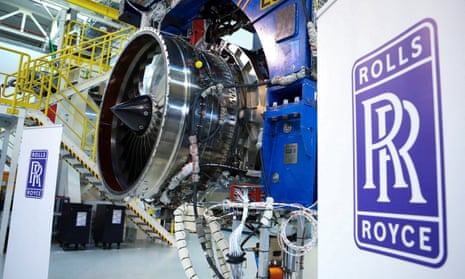Rolls-Royce is to cut up to 2,500 jobs across its business, as its chief executive prepares to reveal his long-term strategy for the company.
The jet engine manufacturer is expected to reveal between 2,000 and 2,500 job losses as early as Tuesday, with the UK expected to be affected, two sources said.
Tufan Erginbilgiç, a former BP executive, took over Rolls-Royce in January and immediately rattled staff by describing it as a “burning platform”, suggesting big changes would be needed to prevent one of Britain’s most venerable and complex manufacturers from falling further behind its rivals.
Rolls-Royce’s financial performance has improved markedly in the past year, mainly thanks to the recovery in global air travel after the coronavirus pandemic. Although its focus on long-haul travel has meant it has lagged behind rivals who make engines for short-haul planes, its share price has more than doubled since the start of 2023 – albeit remaining short of its pre-pandemic level in 2019.
The company’s civil aviation revenues are heavily dependent on selling maintenance services for the engines it makes, meaning it was hit particularly hard during the pandemic. It cut 9,000 jobs then to reduce costs in what was described by its leaders as an existential threat to the business.
Government officials were briefed on the latest redundancy plans on Monday evening, in accordance with statutory requirements relating to job cuts, according to Sky News, which first reported the cuts.
Erginbilgiç previously highlighted to reporters that Rolls-Royce was duplicating work in several areas of the business. It is thought that the cuts will mainly be back-office roles, rather than engineers who work directly with technology.
Rolls-Royce has 42,000 employees, with about half of them in the UK. British jobs are likely to be affected, although the company is not expected to reveal precise numbers this week.
The company has three main divisions: its civil aerospace business making jet engines for bigger passenger planes such as the Airbus A350; a defence business making jet engines for fighters and reactors for nuclear submarines; and a power systems unit that makes engines for boats and generators.
The power systems business is thought to be particularly at risk. In May, Erginbilgiç described it as “grossly mismanaged”. Analysts have said it has much higher costs relative to performance than other parts of the business. It is understood that Erginbilgiç will focus on integrating it into the rest of the company.
Erginbilgiç is planning to update investors next month on his plans for Rolls-Royce over the next few years. Some analysts have suggested the power systems division could be a candidate for a sale, but an effort to more closely integrate it into the rest of the business would make that less likely.
The company is also due to give medium-term targets on how fast it expects to grow sales and profits, which it has refrained from doing while Erginbilgiç has been reviewing company strategy.
Rolls-Royce declined to comment.
